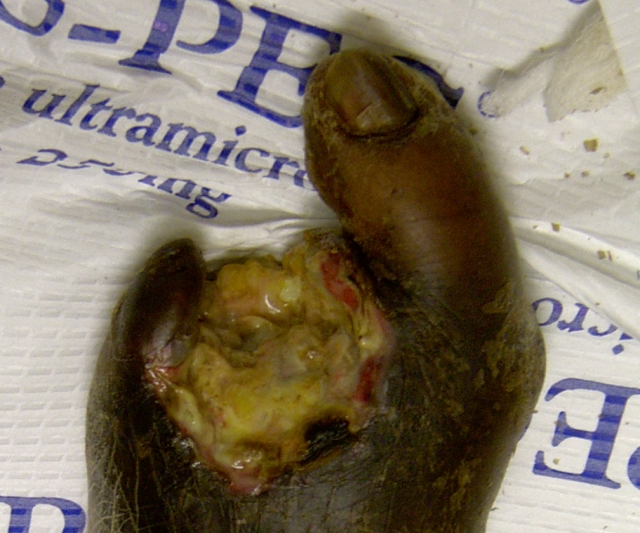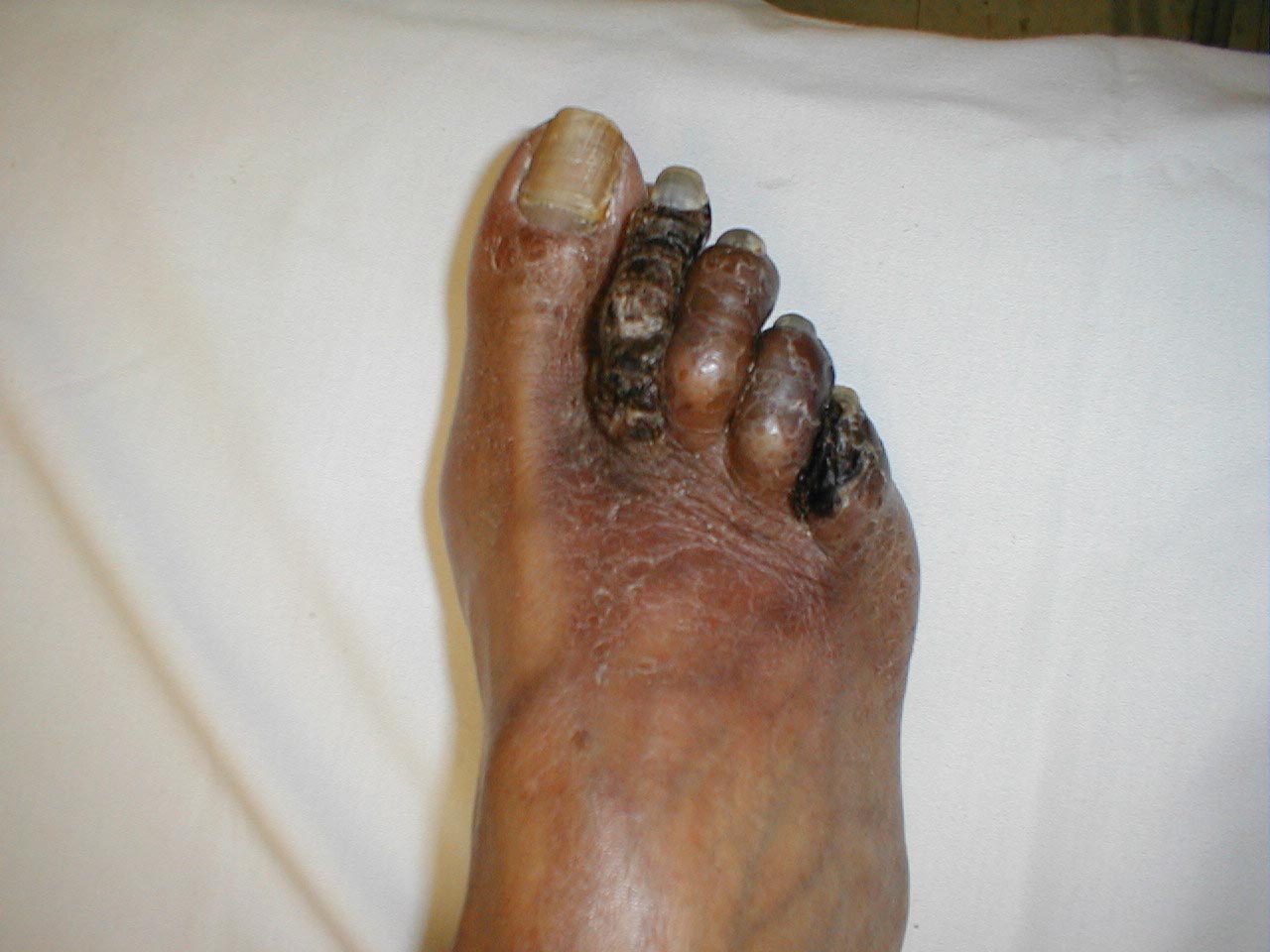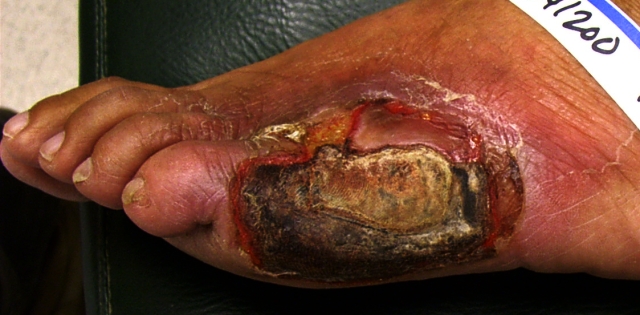Gangrene
| Gangrene | |
 | |
|---|---|
| Diabetic with severe infection and loss of toes - wet gangrene in center. |
|
Gangrene Microchapters |
|
Diagnosis |
|---|
|
Treatment |
|
Case Studies |
|
Gangrene On the Web |
|
American Roentgen Ray Society Images of Gangrene |
Editor-In-Chief: C. Michael Gibson, M.S., M.D. [1]
Gangrene is a complication of necrosis (i.e., cell death) characterized by the decay of body tissues, which become black and malodorous. It is caused by infection or ischemia, such as from thrombosis (blocked blood vessel). It is usually the result of critically insufficient blood supply (e.g., peripheral vascular disease) and is often associated with diabetes and long-term smoking. This condition is most common in the lower extremities. The best treatment for gangrene is revascularization (i.e., restoration of blood flow) of the affected organ, which can reverse some of the effects of necrosis and allow healing. Other treatments include debridement and surgical amputation. The method of treatment is generally determined depending on location of affected tissue and extent of tissue loss. Gangrene may appear as one effect of foot binding.
(Images courtesy of Charlie Goldberg, M.D., UCSD School of Medicine and VA Medical Center, San Diego, CA)
-
Patient with peripheral vascular disease that has lead to infarct of several toes.
-
Same patient. Normal left foot for comparison.
Etymology
The etymology of gangrene derives from the Latin word "gangraena" and from the Greek gangraina (γάγγραινα), which means "putrefaction of tissues".
Types of gangrene
Dry gangrene
Dry gangrene begins at the distal part of the limb due to ischemia and often occurs in the toes and feet of elderly patients due to arteriosclerosis. Dry gangrene spreads slowly until it reaches the point where the blood supply is inadequate to keep tissue viable. Macroscopically, the affected part is dry, shrunken and dark black, resembling mummified flesh. The dark coloration is due to liberation of hemoglobin from hemolyzed red blood cells which is acted upon by hydrogen sulfide (H2S) produced by the bacteria, resulting in formation of black iron sulfide that remains in the tissues[1]. The line of separation usually brings about complete separation with eventual falling off of the gangrenous tissue if it is not removed surgically.
If the blood flow is interrupted for a reason other than severe bacterial infection, the result is a case of dry gangrene. People with impaired peripheral blood flow, such as diabetics, are at greater risk of contracting dry gangrene.
The early signs of dry gangrene are a dull ache and sensation of coldness in the affected area along with pallor of the flesh. If caught early, the process can sometimes be reversed by vascular surgery. However, if necrosis sets in, the affected tissue must be removed just as with wet gangrene.
-
Diabetic ulceration with central "dry" gangrene and toward the edges wet gangrene with some ascending cellulitis
(Image courtesy of Charlie Goldberg, M.D., UCSD School of Medicine and VA Medical Center, San Diego, CA)
Wet gangrene
Wet gangrene occurs in naturally moist tissue and organs such as the mouth, bowel, lungs, cervix, and vulva. Bedsores occurring on body parts such as the sacrum, buttocks and heels—although not necessarily moist areas—are also categorized as wet gangrene infections. In wet gangrene, the tissue is infected by saprogenic microorganisms (Bac.perfringes, fusiformis, putrificans, etc.), which cause tissue to swell and emit a fetid smell. Wet gangrene usually develops rapidly due to blockage of venous and/or arterial blood flow. The affected part is saturated with stagnant blood which promotes the rapid growth of bacteria. The toxic products formed by bacteria are absorbed causing systemic manifestation of septicemia and finally death. Macroscopically, the affected part is edematous, soft, putrid, rotten and dark. The darkness in wet gangrene occurs due to the same mechanism as in dry gangrene.
-
Diabetic with severe infection and loss of toes - wet gangrene in center.
(Image courtesy of Charlie Goldberg, M.D., UCSD School of Medicine and VA Medical Center, San Diego, CA)
Gas gangrene
Gas gangrene is a bacterial infection that produces gas within tissues. It is a deadly form of gangrene usually caused by Clostridium perfringens bacteria. Infection spreads rapidly as the gases produced by bacteria expand and infiltrate healthy tissue in the vicinity. Because of its ability to quickly spread to surrounding tissues, gas gangrene should be treated as a medical emergency.
Gas gangrene is caused by a bacterial exotoxin-producing clostridial species, which are mostly found in soil and other anaerobes (e.g. Bacteroides and anaerobic streptococci). These environmental bacteria may enter the muscle through a wound and subsequently proliferate in necrotic tissue and secrete powerful toxins. These toxins destroy nearby tissue, generating gas at the same time. A gas composition of 5.9% hydrogen, 3.4% carbon dioxide, 74.5% nitrogen and 16.1% oxygen was reported in one clinical case.[2]
Gas gangrene can cause necrosis, gas production, and sepsis. Progression to toxemia and shock is often very rapid.
Specific gangrenes
- Noma is a gangrene of the face.
- Necrotizing fasciitis affects the deeper layers of the skin.
- Fournier gangrene usually affects the male genitals.
Treatment
As early as 1028, when antibiotics had not yet been discovered, fly maggots were commonly used to treat chronic wounds or ulcers to prevent or arrest necrotic spread, as some species of maggots consume only dead flesh, leaving nearby living tissue unaffected. This practice largely died out after the introduction of antibiotics and enzyme to the range of treatments for wounds. Recently, however, maggot therapy has regained some credibility and is sometimes employed with great efficacy in cases of chronic tissue necrosis.
In modern times treatment is usually surgical debridement, and excision with amputation is necessary in many cases. Antibiotics alone are not effective because they do not penetrate ischemic muscles sufficiently.
See also
References
Template:Circulatory and respiratory system symptoms and signs
Template:Skin and subcutaneous tissue symptoms and signs Template:Nervous and musculoskeletal system symptoms and signs Template:Urinary system symptoms and signs Template:Cognition, perception, emotional state and behaviour symptoms and signs Template:Speech and voice symptoms and signs Template:General symptoms and signs
ar:غنغرينة bg:Гангрена ca:Gangrena cs:Gangréna da:Gangræn de:Gangrän et:Gangreen eo:Gangreno fa:قانقاریا io:Gangreno is:Kolbrandur it:Cancrena he:נמק nl:Gangreen no:Koldbrann qu:Kawsaykuq tantalli ismusqa scn:Cancrena fi:Kuolio sv:Kallbrand uk:Гангрена wa:Grangrin


